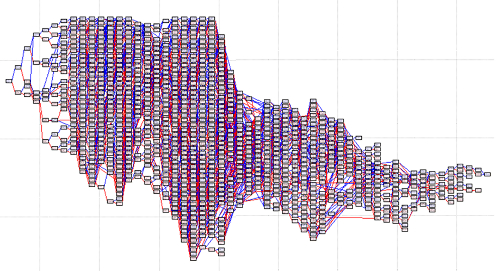
Irish Wolfhound Genetic Diversity Resources
Deutsch
Franšais
"Knowledge is Power!"
There are Irish Wolfhound specialty dog shows held all over the world. While not a strict representation of all breeding activity, they offer a convenient look at what breeding stock are around in a given area at a given time, and therefore are a convenient population to study and analyze.
By accessing this web site, you agree to the Terms of Use.
If you have questions, corrections, commentaries, or would like to contribute information, please send a message to info (at) wolfhound (dot) ch. You can also consult the FAQ.
As explained in
the article I co-wrote with Steve LeVan, Irish Wolfhounds as a breed are currently threatened by a genetic bottleneck event, i.e. a scenario where a particular group of ancestors becomes so widespread within pedigrees that it threatens the availability of alternatives in breeding and hence the freedom of breeders to choose other lines, as well as the genetic diversity of the breed as a whole.The impending bottleneck in Irish Wolfhounds can manifest itself through several paths. At its core lies the Belgian male Quincy of Kilmara, born in 1992. He and his immediate family are so widespread in contemporary pedigrees that there is little doubt that they will become a universal feature of Irish Wolfhound breeding unless a concerted effort is made to avoid this scenario.

|
| Pedigree diagram tracking Quincy of Kilmara (on the left) back to Captain Graham's time (on the right). |
Other than Quincy of Kilmara, who presents a global bottleneck threat, other aspects of the bottleneck are coming through his full siblings. The most widespread one of those is the male Shadow of Kilmara, who was exported to the UK and hence is most prevalent in modern British and Irish pedigrees. Other siblings include the females Quarisma of Kilmara, whose influence can mostly be found in North America, and Sixpence of Kilmara, who can primarily be found in Scandinavian pedigrees and has also been introduced to the American West Coast more recently.
While Quincy's dam Miss Marple from the Good Heath was never bred outside of the breedings that produced Quincy and his siblings and therefore poses no independent bottleneck threat, their sire Nasch from the Good Heath was bred to other bitches, making him a related problem that can come down through pedigrees that are independent from Quincy and his siblings. Nasch should therefore be considered separately when looking at the problem.
Given that the dogs that account for our present bottleneck threat are now five to ten generations back, they often no longer show up in standard length pedigrees, and novice breeders are not necessarily even aware of their presence and can find it a challenge to research pedigrees with this concern in mind.
Over the past years, I have often been approached by breeders who are sincerely interested in keeping and maintaining a non-bottleneck line of Irish Wolfhounds. Those breeders commonly voice their frustrations with how difficult it is to identify potential non-bottleneck breeding stock among the large number of today's bottleneck dogs, and that a list of such non-bottleneck dogs would be a very useful tool for them.
As is usually the case, knowledge is power, and this site's purpose is to make information on contemporary non-bottleneck dogs more widely available, with the goal of aiding breeders who are looking to preserve an Irish Wolfhound that is not threatened by the loss of genetic diversity associated with the ever-increasing risk of a new genetic bottleneck.
The following analyses are based on a pedigree database that allows me to track modern Irish Wolfhounds all the way back to Captain Graham's time and that I have used previously in several peer-reviewed scientific publications (example). The idea is to look at the pedigrees that show up in modern specialty show catalogs and then identify the dogs who are not subject to the bottleneck in its various expressions. To achieve this, I use five different analytical approaches:
Non-Quincy. Those are dogs whose pedigrees are free from Quincy of Kilmara.
Non-Shadow. Those are dogs whose pedigrees are free from Shadow of Kilmara.
Non-Quincy and non-Shadow. Those are dogs whose pedigrees are free from both Quincy and Shadow of Kilmara.
Non-Quincy and all siblings. Those are dogs whose pedigrees are free from all dogs that go back to the matings of Nasch and Miss Marple from the Good Heath.
Non-Nasch. Those are dogs whose pedigrees are free from Nasch from the Good Heath.
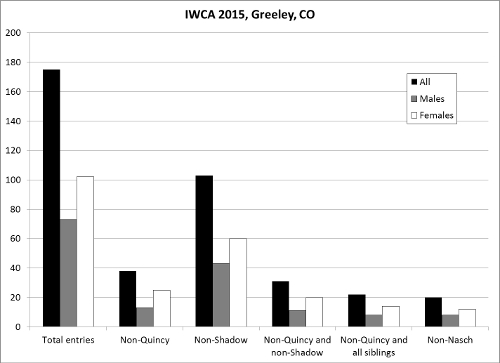 |
| Example: Pedigree analysis of non-bottleneck dogs in the IWCA Nationals 2015 catalog classified by different aspects of the bottleneck. |
Avoiding the Bottleneck as a Breeder [top]
From a breeding point of view, one should keep in mind that the bottleneck is unfortunately something that cannot be avoided by breeding a bottleneck Wolfhound to a non-bottleneck Wolfhound, as any puppies from such a mating will also be subject to the bottleneck. The only way to avoid the problem and to ensure that the bottleneck will not become a breed-wide phenomenon is to keep breeding Wolfhounds who are not subject to the bottleneck to each other.
However, even breeders who at this point have bottleneck dogs exclusively should consider whether it would be compatible with their breeding program to dedicate at least part of their resources to acquiring non-bottleneck stock and using them in such a way as to avoid exposure to the bottleneck among their offspring. Doing so will be rendering a very valuable service to the breed as a whole.
| From a bottleneck avoidance point of view, | ||
| breeding… | to… | is… |
| Bottleneck male/semen | Bottleneck female | mostly neutral. |
| Bottleneck male/semen | Non-bottleneck female | highly detrimental. |
| Non-bottleneck male | Bottleneck female | slightly detrimental. |
| Non-bottleneck male | Non-bottleneck female | beneficial. |
| Non-bottleneck semen | Bottleneck female | highly detrimental. |
| Non-bottleneck semen | Non-bottleneck female | beneficial. |
| Overview of different breeding scenarios and their effect on the genetic diversity of the breed as a whole. | ||
Considering the nature of reproduction, the worst thing a breeder can do for the genetic diversity of our breed is to breed a non-bottleneck bitch to a bottleneck male, thus wasting her limited reproductive resources on perpetuating the bottleneck. Using frozen semen from a non-bottleneck male on a bottleneck bitch is no better: This, too is a finite resource that is thus wasted from a genetic diversity point of view.
Of course, it takes two to tango, which means that the owner of a stud dog subject to the bottleneck is also called upon to ensure that this dog is not bred to any non-bottleneck bitches. Obviously, the analog consideration applies to owners of frozen sperm from males that are not subject to the bottleneck.
In contrast, using a live non-bottleneck male on a bottleneck bitch is not inherently wasteful, though not beneficial for the breed's genetic diversity under the aspect of bottleneck avoidance either. This is because as opposed to the situation with frozen semen or a bitch, using a live non-bottleneck male on a bottleneck bitch does not prevent him from being used on a non-bottleneck partner in the same immediate fashion it does with a bitch or with frozen semen.
However, both this practice and the practice of breeding two bottleneck Wolfhounds to each other must be considered slightly detrimental to the overall genetic diversity of the breed, as they both contribute to the reduced percentage in non-bottleneck dogs as a proportion of the whole breed that we see over time.
Lists of Non-Bottleneck Irish Wolfhounds [top]
With the above in mind, I present the following lists of dogs who are not affected by the impending bottleneck, as defined above. Clicking on the links will take you to the site dedicated to the show in question, where there are links to the lists of names.
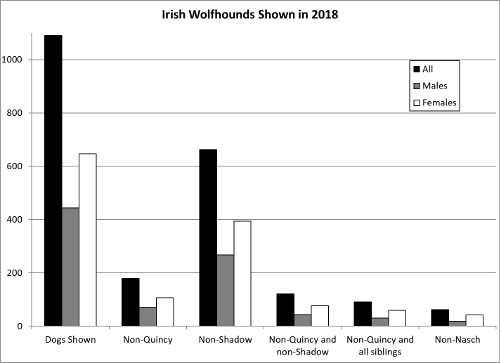 |
| Summary of Irish Wolfhounds Shown in 2018 |
IWCA 2000 (Afton, OK)
IWCA 2006 (St. Louis, MO)
IWCA 2010 (Pleasanton, CA)
IWAGS 2013 (Matamoras, PA)
PVIWC 2014 (Bel Air, MD)
IWCA 2014 (St. Louis, MO)
IWANE 2014 (Boxborough, MA)
PVIWC 2015 (Bel Air, MD)
IWCA 2015 (Greeley, CO)
IWAWC 2015 (Lompoc, CA)
IWANE 2015 (Boxborough, MA)
IWCPS 2015 (Auburn, WA)
RMIWA 2015 (Greeley, CO)
IWADV 2015 (Mohnton, PA)
NorCal 2015 (Petaluma, CA)
LGIWA 2015 (Edwardsville, IL)
IWAGS 2015 (Matamoras, PA)
PVIWC 2016 (Bel Air, MD)
IWCA 2016 (Gray Summit, MO)
IWCC-BC 2016 (White Rock, BC)
IWAWC 2016 (Lompoc, CA)
IWANE 2016 (Boxborough, MA)
IWCPS 2016 (Auburn, WA)
RMIWA 2016 (Greeley, CO)
IWCC 2016 (Elmvale, ON)
NorCal 2016 (Petaluma, CA)
IWADV 2016 (Mohnton, PA)
LGIWA 2016 (Edwardsville, IL)
IWAGS 2016 (Matamoras, PA)
PVIWC 2017 (Bel Air, MD)
IWCA 2017 (Geneva, NY)
Northstar 2017 (Isanti, MN)
IWAWC 2017 (Lompoc, CA)
IWCPS 2017 (Auburn, WA)
IWANE 2017 (Boxborough, MA)
RMIWA 2017 (Greeley, CO)
GLIWA 2017 (Caledonia, WI)
IWCC 2017 (Mission, BC)
IWADV 2017 (Mohnton, PA)
IWAGS 2017 (Matamoras, PA)
PVIWA 2018 (Bel Air, MD)
IWCA 2018 (Gray Summit, MO)
Northstar 2018 (Isanti, MN)
IWAWC 2018 (Camarillo, CA)
IWCPS 2018 (Auburn, WA)
IWANE 2018 (Boxborough, MA)
RMIWA 2018 (Greeley, CO)
IWCC 2018 (Ridgeway, ON)
GLIWA 2018 (St. Francis, WI)
IWADV 2018 (Mohnton, PA)
NorCal 2018 (Petaluma, CA)
IWAGS 2018 (Matamoras, PA)
PVIWC 2019 (Bel Air, MD)
IWCA 2019 (Santa Fe, NM)
IWAWC 2019 (Lompoc, CA)
IWANE 2019 (East Windsor, CT)
Continental European Shows [top]
IWCS 2012 (Basel, Switzerland)
EIWC 2014 (Helsinki, Finland)
JAS 2014 (Donaueschingen, Germany)
JAS 2015 (Cologne, Germany)
RALIE 2015 (Coussac-Bonneval, France)
RALIE 2016 (Appoigny, France)
EIWC 2016 (N÷rten-Hardenberg, Germany)
RALIE 2017 (Mont-Saint-Michel, France)
JAS 2017 (Gelsenkirchen, Germany)
FIWC 2018 (Le Touquet, France)
JAS 2018 (Hildesheim, Germany)
IW Club Championship Show 2015 (Coventry, UK)
Crufts 2015 (placements only; Birmingham, UK)
IWCI 2015 (Dublin, Ireland)
IW Society Championship Show 2015 (Coventry, UK)
IWCNI 2015 (Hillsborough, Co. Down)
Crufts 2016 (Birmingham, UK)
IW Club Championship Show 2016 (Coventry, UK)
IWCI 2016 (Dublin, Ireland)
IW Society Open Show 2017 (placements only; Ryton-on-Dunsmore, UK)
Crufts 2017 (placements only; Birmingham, UK)
Crufts 2018 (Birmingham, UK)
IWCI 2018 (Celbridge, Ireland)
IWCSA 2015 (Adelaide, SA, Australia)
Comparisons and Trends [top]
Having access to information from different regions of the world and different points in time allows us to also follow how the bottleneck has developed in Irish Wolfhounds and which regions are affected to what degree.
IWCA 2006, 2014 and 2015 [top]
IWCI and IWCA 2015 and EIWC 2014 [top]
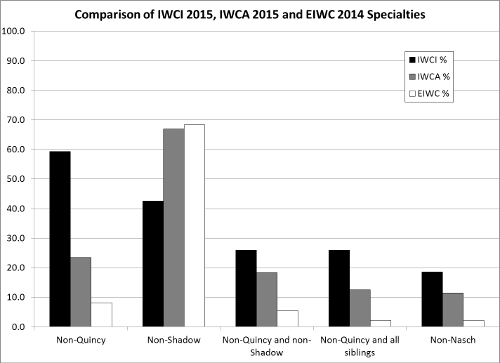 |
| Comparing contemporary specialty shows in
Ireland, North America and Continental Europe, we note that the
bottleneck is most prominent in Continental Europe, and that Ireland is
the least affected country at this point. The exception is where the
bottleneck comes through Shadow of Kilmara, who is a more common
ancestor in Ireland (and the UK) than elsewhere. Note that the difference between non-Quincy and non-Shadow versus non-Quincy and all siblings is more marked in the US and Continental Europe, which is primarily due to the influence of Quarisma and Sixpence of Kilmara respectively. |
Shows in Continental Europe [top]
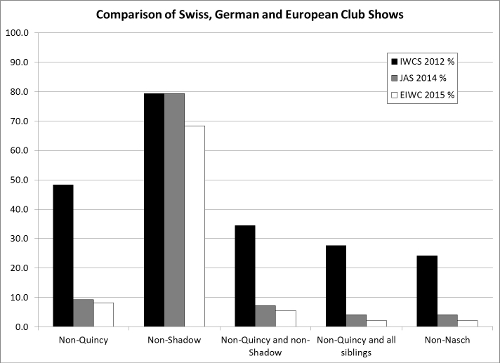 |
| Comparison between Specialty Shows in continental Europe, demonstrating that important differences exist between continental European regions, with Switzerland having a more substantial percentage of non-bottleneck dogs than comparable shows elsewhere on the Continent. |
| (c) 2007-2019 wolfhound.ch |
Last Update: 31 Jul 2019
|